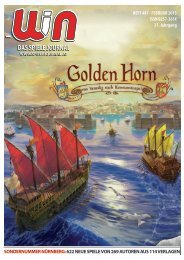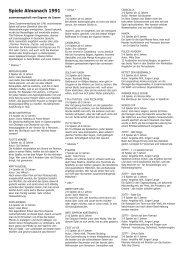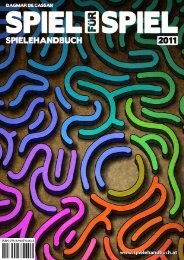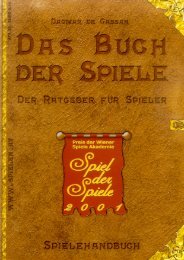THE GAMES JOURNAL - Österreichisches Spiele Museum
THE GAMES JOURNAL - Österreichisches Spiele Museum
THE GAMES JOURNAL - Österreichisches Spiele Museum
You also want an ePaper? Increase the reach of your titles
YUMPU automatically turns print PDFs into web optimized ePapers that Google loves.
Verräter from Adlung <strong>Spiele</strong>. Faidutti has<br />
�ne-tuned Casasola Merkles basic idea for<br />
Citadels especially as to the interaction of<br />
the characters and has taken it up again<br />
for Lost Temple nearly unchanged.<br />
At the start of each round the nine character<br />
cards are shu�ed. In relation to the<br />
number of the players a given amount of<br />
cards is set aside face-up and face-down.<br />
In case of �ve players, for instance, two<br />
cards are placed open-faced and one card<br />
face-down. Then the starting-player is<br />
handed the remaining cards and secretly<br />
chooses one of them which he keeps<br />
and sets down face-down. The remaining<br />
cards are handed on in clock-wise direction;<br />
each player chooses one and sets it<br />
down.<br />
Klemens Franz<br />
Lost temple is proof that the well-tested mechanism of<br />
character choice works in a move & roll game, too. Not so<br />
“nasty” as its predecessors!<br />
The last player has only two cards to<br />
choose from. The last card is set down<br />
face-down, too, and here we already<br />
have an interesting situation: The starting<br />
player knows which cards are in play<br />
but not which card is left-over at the end<br />
of the round. The admittedly rather big<br />
advantage for the starting player is a bit<br />
mitigated by this, especially as each other<br />
player has at least an inkling of what his<br />
predecessor could have chosen and what<br />
is left for the next player.<br />
The reason for it being important to know<br />
who did choose which character lies in the<br />
interwoven functions of the characters.<br />
When all players have chosen a card the<br />
characters – not the players! – are called in<br />
a pre-de�ned sequence. First the Shaman,<br />
who must name another character – not<br />
player! – with whom he wants to change<br />
places when this character is called. And<br />
here the dilemma becomes obvious: The<br />
Shaman is exceedingly powerful, as he<br />
can topple the current positions on the<br />
board. But only if he chooses a character<br />
that, �rst, is in play and, second, belongs<br />
to a player that is ahead of the Shaman.<br />
In the worst case a bad choice can catapult<br />
the player of the Shaman into last<br />
position, gleeful laughter of the others<br />
included.<br />
The case of the Thief is similar, who can<br />
steal all emeralds from a character – exactly,<br />
not from a player! – but, again, only<br />
if he chooses a character that is in play and<br />
whose “owner” has emeralds in his possession.<br />
These plastic gems are the currency<br />
of the game, which some characters must<br />
use in order to be able to move. The priest,<br />
for instance, can discard two emeralds in<br />
order to move to the next temple spot.<br />
The Elder works basically the same way,<br />
only that he moves to the next village. The<br />
Scout, on the other hand, can exchange<br />
his emeralds 1:1 for movement points.<br />
The Canoe (correctly, the card should be<br />
named Canute) changes emeralds into<br />
double the amount of movement points,<br />
up to a maximum of 20 points. If you<br />
hoard emeralds in order to use the Scout<br />
or the Canoe soon you are course a preferred<br />
target for the Thief. The Seer enables<br />
a player to take a look at the event<br />
tiles on the board and to switch them. As<br />
each turn only provides one emerald for<br />
supplies it can sometimes be necessary<br />
to place a tile providing several emeralds<br />
in front one oneself, as the Seer can take<br />
one or two steps after looking at tiles.<br />
The Craftsman receives a machete and<br />
can take up to two steps. And, �nally, the<br />
Child, that moves forward to the next<br />
pawn in front.<br />
Faidutti here has fallen back deliberately<br />
not only on a proven mechanism but on a<br />
proven dynamic, too. Following the motto<br />
of „I think that you think, because you plan<br />
to do this and that … and so I hope that”<br />
jolly guessing and speculating develops<br />
on who might have chosen which character<br />
in relation to the current situation. A<br />
remaining rest of uncertainty provides the<br />
necessary levity. So we do not have silent<br />
musings at the table but a lively interaction<br />
to and fro, pro and con.<br />
It is just fun to get away unscathed with<br />
the chosen character or to “catch” the intended<br />
character. In this aspect, all the<br />
same, Lost Temple comes over a bit tamer<br />
than Citadels. It is not that nasty and destructive<br />
and thus clearly more suitable<br />
for families. Where you could get caught<br />
and sometimes hat do get caught in an<br />
exchange of tit-for-tat you need to keep<br />
an eye on speed in Lost Temple. There are<br />
few sources for income, but many many<br />
possibilities to change emeralds into<br />
movement. The thereby evolving focus<br />
on the plastic gems concentrates the attention<br />
of all players on one element and<br />
thus provides potential for con�icts. And<br />
again, due to the lack of buildings, which<br />
in Citadels have additional functions of<br />
their own and in combination with the<br />
characters, Lost Temple is the more approachable<br />
game. The path to the �nish<br />
is clearly staked, but stays interesting<br />
throughout. There might be games where<br />
nothing goes right but thanks to a relatively<br />
short time for playing a game you<br />
LOST TEMPLE t<br />
OUR REVIEW<br />
can live with this. Nobody gets really massively<br />
left behind – a cleverly used Shaman<br />
can turn events – but such a masterly<br />
move needs to work before you can cheer.<br />
These situations and considerations de-<br />
�ne Lost Temple. When you have mastered<br />
the mechanism, two to eight players<br />
can immerse themselves in a lovely family<br />
game. In case of two and three players,<br />
each player chooses two characters, which<br />
works well, too, and makes the game a bit<br />
more tactical, but real fun emerges when<br />
four and more play. In general you can say,<br />
as in many of those games, the more the<br />
merrier and the more chaotic!<br />
As regards to the question at the start,<br />
why Casasola Merkles idea is not used<br />
more often? At �rst glance the mechanisms<br />
looks substantially more concrete<br />
in its structure as the sequence in which<br />
characters are chosen, is clearly preset.<br />
To pick up such a pre-de�ned structure<br />
might be a big hurdle for many designers,<br />
even if that what you do with the characters<br />
chosen is as up to their fancy as is<br />
worker placement. And therefore it would<br />
be nice if the felicitous Lost Temple did<br />
not remain the last of its kind. �<br />
Klemens Franz<br />
www.atelier198.com<br />
INFORMATION<br />
PLAYERS:<br />
Designer: Bruno Faidutti<br />
2-8<br />
Gra�k: Pierô<br />
AGE:<br />
Price: ca. 30 Euro<br />
10+<br />
Publisher: White Goblin Games 2011 TIME:<br />
www.whitegoblingames.nl<br />
40+<br />
EVALUATION<br />
Movement game with choice of characters<br />
For families<br />
Version: multi<br />
Rules: en, fr, nl, de<br />
In-game text: yes<br />
Comments:<br />
Basically a simple movement game *<br />
Well-known mechanism of character<br />
choice<br />
Compares to:<br />
Ohne Furcht und Adel, Verräter, Tal der<br />
Abentuer<br />
Other editions:<br />
Arclight, Japan; Stronghold, USA; Lifestyle Ltd.,<br />
Russia<br />
WIN The Games Journal now also available as eBook!<br />
www.gamesjournal.at ISSUE 434 / FEBRUARY 2012 21<br />
For all information on that check our website.<br />
My rating:









